Legend: Definitions, Terms, <Text>, [IPA], -Tags-, and "Glosses".
Content word glyphs are (mostly) enclosed. Verbs are enclosed in hexagons while nouns are enclosed in rectangles. Each enclosure has a number of outside connecting points, each corresponding to an argument role, with additional connections for clause nominalization and adverbs. Lines attached to the appropriate connecting points connect the enclosures to each other. Each content word glyph has a definite top, left, right, and bottom, so that the connecting points can be distinguished when the symbol is rotated.
There's also a pentagon used for partitive constructions, a triangle used for name constructions, and a small rectangle used for the standard of comparison.
Quantity words and certain modal words are not enclosed.
Note: the locational verbs "here", "there", and "yonder" are not enclosed when used as determiners, since there's only 1 connection point.
The numbers in the tables below correspond to those in the diagram.
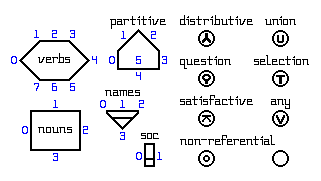
| Verb Connectors | Noun Connectors | ||
| # | Description | # | Description |
|---|---|---|---|
| 0 | clause nominalization | 0 | clause nominalization |
| 1 | recipient or beneficiary | 1 | possessor |
| 2 | agent, donor, or actor | 2 | similarity or kind |
| 3 | patient, theme, or locatee | 3 | possessum |
| 4 | manner, degree, or source | ||
| 5 | time when | ||
| 6 | location | ||
| 7 | instrument | ||
| Partitives | Names | SOC | |||
| # | Description | # | Description | # | Description |
|---|---|---|---|---|---|
| 0 | clause nominalization | 0 | clause nominalization | 0 | subject of comparison |
| 1 | part cardinality | 1 | phrase | 1 | standard of comparison |
| 2 | whole | 2 | nominator | ||
| 3 | degree adverb | 3 | proper noun | ||
| 4 | part | ||||
| 5 | selector | ||||
Lines may join or split; as this always occurs at a small circle, lines may otherwise cross without non-connection being marked. The circle may also enclose a small symbol representing a determiner or conjunction. Empty circles either represent the null determiner or are used to split the line for coreference. For non-symmetrical symbols, the output connection is at the bottom of the circle, assuming the orientation shown in the diagram. As with the other enclosures, rotation is possible.
| Symbol Description | Usage Description | Type |
|---|---|---|
| U-shape | all referent groups | conjunction |
| T-shape | only one of the referent groups | |
| V-shape | at least one of the referent groups | |
| o-shape | non-referential | determiner |
| Q-shape | content question | |
| rotated K-shape | satisfactive | |
| (none) | other | |
| (none) | coreference | other |
| inverted Y-shape | distributive |
Symbols marked directly on lines have different usages, depending on which line they appear on.
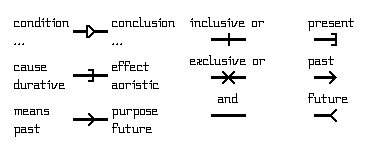
| Symbol Description | Clause Nominalization | Time When |
|---|---|---|
| open arrow | means-purpose | past-future |
| closed arrow | condition-conclusion | |
| bracket | cause-effect | durative-aoristic |
| bar | inclusive OR | |
| x-shape | exclusive OR | |
| (none) | AND |
Time-when lines may terminate with only one end connected; these have terminal symbols, as shown in the diagram above.
| Symbol Description | Usage Description |
|---|---|
| arrow | past tense |
| reverse arrow | future tense |
| bracket | present tense |
The pronoun symbols are shown here and usually appear next to the appropriate connection point or circle without any line. The labels in the table below correspond to those in the diagram. There's no need for 3rd person or reflexive pronouns.
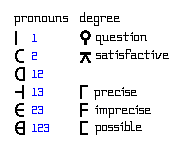
| Pronouns | |
| # | Description |
|---|---|
| 1 | speaker |
| 2 | addressee |
| 3 | associated others |
The satisfactive and question degree symbols may appear next to the adverb connection point without any line, as do the precision symbols, which may be glossed as "slightly X", "very X", and "as X as possible".
Besides the glyph, polarity and scalar direction symbols appear inside the verb enclosures; polarity can also appear within noun enclosures.
Polarity is marked near the clause nominalization connecting point.
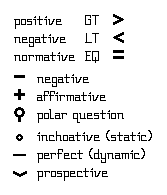
| Symbol Description | Usage Description |
|---|---|
| (none) | positive |
| – | negative |
| + | affirmative |
| Q-shape | polar question |
Scalar direction applies to scalar verbs. It's marked near the adverbial connecting point. For superlatives, it can appear above the selector instead.
| Symbol Description | Usage Description |
|---|---|
| > | positive, greater than, most |
| < | negative, less than, least |
| = | normative, equative |
| (none) | absolute |
Each verb has an action type: static, denoting a state, or dynamic, denoting an action. Static verbs are basically stative or perfect while dynamic verbs are basically aoristic or progressive. However, the basic aspect can be overridden by a symbol placed above the glyph, according to the following table and referring to the diagram above:
| Symbol Description | Name | Static Usage | Dynamic Usage |
|---|---|---|---|
| tiny circle | inchoative | aoristic/progressive | - |
| line | perfect | - | perfect |
| wing-shape | prospective | prospective | prospective |
| (none) | stative/perfect | aoristic/progressive |

The potential and inevitable (natural possibility and necessity) modals are represented by verb prefixes. The glosses used for them are N for inevitable and P for potential. The conative is also represented by a prefix, which is glossed as C.
Compound nouns using a pair of glyphs is a possibility. In a few cases, glyph component alternation between words is semantically significant.
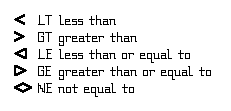
Numeric glyphs may be modified using a suffix to represent a range of values, where the numeric quantity is 1 endpoint of the range.
A phrase can be a single word, or it can be multiple words, connected using circles. Simple phrases typically use a single circle to join the words of the phrase, which may be nouns, verbs used attributively, or quantity words. The determiner, if any, appears in the circle.
A compound phrase consists of 2 or more component phrase joined using a circle containing a phrase conjunction. Compounding is hierarchical.
There are no dedicated glyphs for proper nouns. Instead, an otherwise normal phrase can be made into a proper noun using a triangle. Besides the phrase input and the name output, there's an optional nominator argument, which specifies the entities who apply the name to its referent.
Partitive constructions reference a subset selected from a set denoted by the input phrase (the whole). The selection criterion may be a superlative, and ordinal number, or unspecified, according to the selector connection. If superlative or ordinal, there may be a degree connection. The cardinality of the part may also be specified.
The time when line connects to phrases specifying the time of the situation, the number of occurrences, or the frequency of occurrences.
Terminal line symbols, which specify absolute time, appear only on time when lines as do time relation symbols, which specify relative time. However, a context-relative time relation for an attributive verb is marked on the line connecting it to the phrase (or directly to the matrix verb).
When the time when line connects to a phrase indicating multiple occurrences, the aspect is pluractional. If the time of the situation is also specified, the line must be split.
The clause nominalization line is primarily used to nominalize or subordinate a clause, but is also used for other clause relationships, according to the line symbol. When the clause is subordinated, the other end of the line connects to the patient or theme connector of the auxiliary verb.
The manner, degree, or source line is used on dynamic verbs to specify the manner in which the action is done and on scalar verbs to specify the scalar degree or precision. With a few verbs, such as "make", it's also used for the source or material or point of origin.
The other 5 verb connection points are used for argument phrase lines or pronouns.
When the agent, donor, or actor line and another argument line to the same verb (such as the patient, theme, or locatee or the recipient or beneficiary), are connected, the verb is either reflexive or reciprocal. This depends on the number of the argument phrase or pronoun connected to the line; if the argument is singular or distributive, the verb is reflexive while if the argument is collective, the verb is reciprocal.
The possessum connecting point provides the meaning of the noun; its use is required.
The possessor connecting point may connect to a possessor phrase or pronoun.
The similarity or kind connecting point is used for a phrase or pronoun to which the entity is similar or a phrase specifying the kind, given the entity as generic.
The clause nominalization line is primarily used to nominalize or subordinate the copular clause, but is also used for other relationships, according to the line symbol. When the clause is subordinated, the other end of the line connects to the patient or theme connector of the auxiliary verb.
The clause nominalization line is primarily used to nominalize or subordinate the partitive clause, but is also used for other relationships, according to the line symbol. When the clause is subordinated, the other end of the line connects to the patient or theme connector of the auxiliary verb.
The whole connection point is used for the phrase or pronoun representing the set from which the part is selected while the part line is used for the selected subset; both of these are required.
The selector is either a scalar verb used as a superlative, a quantity word used as an ordinal number, or omitted. The part cardinality line connects to a quantity word specifying the size of the subset; it's required if the selector is omitted. The degree adverb connection point is used for the degree of difference between the superlative subset and the remainder of the set and can apply only when the selector is superlative.
The clause nominalization line is primarily used to nominalize or subordinate the name construction clause, but is also used for other relationships, according to the line symbol. When the clause is subordinated, the other end of the line connects to the patient or theme connector of the auxiliary verb.
The phrase line connects to the phrase used as a name, while the proper noun line is the entity named; both of these are required. The nominator connection point is used for the entity that applies the phrase as a name for the entity named.
A subject of comparison is explicitly or implicitly compared to some standard of comparison with respect to some scale of comparison. The scale of comparison is a scalar verb or a scalar quantity such as "many" or "much". The scale of comparison is accompanied by the direction of comparison: more, less, or equal (although in absolute usage, the direction of comparison is not relevent). Also involved is an adverbial element, the degree of comparison, which may take the form of precision specifying an inexact amount of difference between the subject of comparison and the standard ("a little/slightly" or "a lot/very").
Note: Only 1 of a set of scalar words differing only in direction is used as the gloss, since there's only 1 glyph per set. The word used will usually be the one with positive direction, e.g. "tall" for "tall/short/height".
A degree phrase consists of a quantity word and a units noun, connected to the degree connection point of the verb or partitive enclosure.
When the construction is a superlative, it denotes the difference in degree from that of the other entities in the set denoted by the input phrase. In a comparative clause, it denotes the difference in degree from the standard of comparison to the subject of comparison. It is also for absolute degree (where the scalar is not marked for direction).
When the scalar is absolute it normally connects to a degree phrase, or is marked with the question symbol. If no degree is specified, it indicates that specified quality is applicable to the patient or theme.
The SOC enclosure appears when the clause is comparative or equative. The comparison may be temporal, in which case the standard of comparison is a terminal line symbol specifying relative tense (in this usage). Otherwise, the standard of comparison is a pronoun or connects to a phrase.
A satisfactive sentence consists of a satisfactive part and a result part. The satisfactive part must contain one of the satisfactive symbols, such as the determiner or the degree symbol. The main satisfactive part verb's clause nominalization line connects to the main result part verb's clause nominalization line in a cause-effect relation, with the satisfactive part being the cause and the result part being the effect. The 2 parts have the same tense if the result is actual; if not, the result tense is unmarked.
The inevitable and potential modals are represented by verb prefixes. The glosses used are N and P. The deontic necessity and possibility modals are represented by the auxiliary verbs "require" (DN) and "permit" (DP), respectively. The volitive necessity and possibility modals are represented by the auxiliary verbs "want" (VN) and "okay with" (VP), respectively. The epistemic necessity and possibility modals have both full forms and abbreviated forms. The full forms are represented by auxiliary verbs. The abbreviated forms are represented by unenclosed glyphs that appear at the subordinate verb's clause nominalization connecting point. The glosses used for both forms are EN (necessity) and EP (possibility).
When the polar question symbol and an epistemic modal glyphs are both needed, the former appears outside the main verb enclosure with the latter. In this case, a negative or an affirmative polarity symbol may appear in the usual place.
The imperative mood is represented by a glyph which is glossed IM. This mood has both full and abbreviated forms, constructed like those of the epistemic modals.
Where 2 verbs are in temporal sequence (i.e. past-future) and 1 of them has absolute tense, a circle is used with 3 lines: the absolute tense line and a line to each verb's time when connecting point. The relative tense is marked on the line to the verb whose tense is relative to the other (not absolute).
If the relation is durative-aoristic, it can be marked on the line to either verb.
There are no dedicated secondary predicate structures.
For depictives, an additional verb is used with at least 1 argument in common with the main verb. The time when must be specified as present relative to that of the main verb; otherwise, it will be interpreted as a phrase modifier.
Resultatives are more complicated. The result verb is specified as either an effect for which the main verb is the cause or a purpose for which the main verb is a means. Tense marked on the main verb makes the construction non-perfect while tense marked on the result verb makes it perfect. Note that some resultatives can be translated without a main verb by using the agent, donor, or actor connection point of the result verb.
In direct speech, the quoted speech is reproduced verbatim. Each block of quotation is placed within a superenclosure (which doesn't have to be any particular shape). The speaker of the quoted speech appears as the agent, donor, or actor of a speech verb such as "tell" or "ask" while the addressee appears as its recipient or benficiary. The patient, theme, or locatee line of the speech verb connects to the superenclosure; in this case, the connection acts like a clause nominalization connecting point. Any line connecting 2 superenclosures acts like a time when line; this is used mostly for sequencing.
In indirect speech, no superenclosure is needed; the patient, theme, or locatee line of the speech verb connects to the clause nominalization connecting point of the main verb of the quotation. Any pronouns must be adjusted according to the context.
Embedded statements are like independent statements except for the following:
Embedded questions (whether polar or content) differ from independent questions in that:
Embedded commands differ from independent commands in that:
page started: 2015.Nov.21 Sat
current date: 2015.Dec.10 Thu
content and form originated by qiihoskeh
Table of Contents